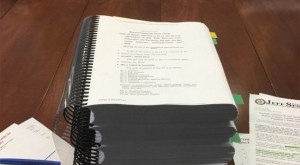Last week Congress averted the annual year-end scare over a government shutdown, passing an “omnibus” appropriation bill that funds the government for a few more months. The 2,000-page monster bill contained plenty for everyone on both sides to hate, and it has been criticized by lots of folks on both sides.
I know people on both sides with the same question: “What could congressional leaders possibly be thinking, to continue this insane process?” It seems that no matter what changes voters demand, and despite a new House Speaker that everyone hopes can return a sense of regular order to the proceedings, nothing changes. But believe it or not, this new bill represents major progress on exactly that – regular order. You see, in recent years Congress has been unable to agree on ANY version of the regular appropriation bills. So they pass a massive “continuing resolution” at the end of the previous cycle, simply “continuing” all programs at the existing level until a specific expiration date, so passing them just kicks the can down the road – putting off any tough decisions to the next round.The trouble is, many of these continuing resolutions have also become Christmas trees, on which Members hang all sorts of pet projects, without going through the regular committee process. Thus, it is no longer about explaining their ideas to each other, and achieving a consensus. Rather, it’s all about who can make back-room deals while bills are created away from public view. And because of the threat of a government shutdown, Members must pass these monster bills, no matter what is hidden in the fine print. A “continuing resolution” should only be one page, but in fact they now typically run to hundreds of pages, and nobody really knows what’s in them until after they pass.
An “omnibus” appropriation bill, by contrast, is a conglomeration of several of the regular appropriation bills that have, in fact, come through the regular committee process. They are lumped together only because the legislature ran out of time to handle each one separately on the floor. That is still far from ideal, but it is a huge improvement over the “continuing resolution” process. Hopefully, it is a first step.
As Speaker Paul Ryan and other congressional leaders begin the new year (Ryan’s first chance to oversee the entire process), they have a chance to completely change this process and eliminate once and for all the outrageous prospect of government shutdowns that holds democratic decision-making hostage. There should never be another, and there is an easy way to take that off the table – a way that would never again risk sending workers home, closing parks, holding up people’s checks, or endangering national security. Debates over touchy issues like funding Planned Parenthood, or reigning in the EPA, would focus on the details of these issues, without the threatened veto raising the political stakes beyond what the issues merit.
Under the Constitution, Congress has control, not just of spending amounts, but also the structure of the appropriations process itself. As I have mentioned before, the easy solution is to blow that process apart. Congress organizes spending according to the structure of the executive branch, with 12 separate appropriation bills for groups of similar agencies. There’s one for Interior, EPA, and related agencies, for example, and another for Labor, Health and Human Services, Education, and related agencies. But there is nothing requiring Congress to organize it that way.
The simple solution is to break those 12 annual spending bills into 100. There are 15 cabinet departments and about 75 independent agencies. A separate bill for each one would make the process more transparent for everyone. Best of all, if Congress wanted to stop funding the war on coal, the EPA’s proposed Waters of the US regulation, or particular activities of the IRS, NSA, or FCC, it could simply not pass that particular bill, or pass it with very specific restrictions. Doing so would cause nothing else to shut down, even if the President vetoed the bill. No one’s Social Security check would be in danger. Our troops would still be fully funded, as would every other function that most Americans would not want to jeopardize.
Thus, if the President wanted to veto a bill over some restriction it contained, he would not be shutting down the entire government, just one agency. That would put Congress back in the driver’s seat, and create simple choices such as “stop the EPA power grab or shut down the EPA.” What a turnaround.
(An abridged version of this column appeared in the Grand Junction Daily Sentinel December 25, 2015.)





Comments on this entry are closed.